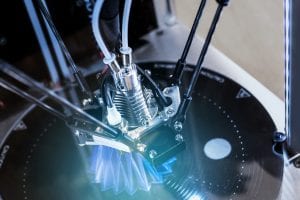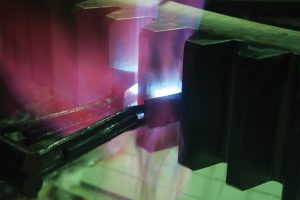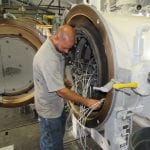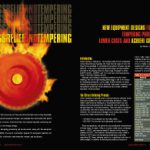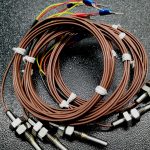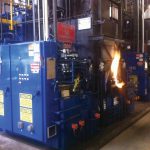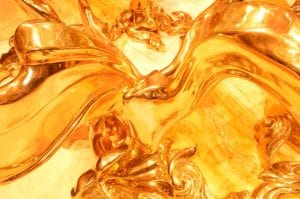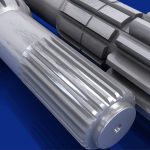Confusion surrounding the case-hardening techniques of nitrocarburizing and carbonitriding prove the point that it’s easy to get lost in the nomenclature behind heat-treating processes.
That comes with the territory. Metallurgy is complicated.
But there’s value to explaining the differences between these techniques1 and the benefits that result from their uses, including cutting down on the confusion to help manufacturers better understand what goes on in the heat treater’s furnaces.
Case Hardening
Case hardening2 refers to the “case” that develops around a part subjected to a hardening treatment. Nitrocarburizing and carbonitriding both make a workpiece surface harder by imparting carbon, or carbon and nitrogen, to its surface.
Metallurgist Adolph Machlet developed nitriding by accident in 1906. That year, he applied for a patent that called for replacing atmosphere air in a furnace with ammonia to avoid oxidation of steel parts. Shortly after he sent the patent application off, he noticed that treating parts in an ammonia atmosphere at elevated temperatures caused a “skin, casing, shell, or coating” to develop around a piece that was extremely difficult to corrode or tarnish.
Also in 1906, German metallurgist Adolph Fry led a research program during which he made the same discoveries Machlet made. He also noticed that adding alloying elements to iron heavily influenced the results of nitriding.
Material, part specs, and intended uses dictate whether nitrocarburizing or carbonitriding is the best case-hardening method.
Carbonitriding
During carbonitriding, parts are heated in a sealed chamber well into the austenitic range — about 1,600 degrees Fahrenheit — before nitrogen and carbon are added. Because the part is heated into the austenitic range, a phase change in the steel’s crystal structure occurs that allows carbon and nitrogen atoms to diffuse into the part.
Nitrogen is added to low-carbon, low-alloy steels because they don’t harden well without the boost the nitrogen provides. The nitrogen comes in the form of ammonia gas molecules that crack apart on the surface of the part to provide nitrogen that diffuses into the steel. Adding nitrogen also helps a part maintain hardness during use in high-temperature operational conditions.
Carbonitriding typically achieves greater case depths compared to nitrocarburizing. There’s no theoretical limit to how deep a case can be achieved in either process, but a practical limit is the time and resources one is willing to spend to achieve certain case depths.
The carbonitriding process takes from a few hours up to a day or more to achieve the desired results: a part with high surface hardness but with a relatively ductile core. The process concludes with a quench.
Carbonitriding is used to harden surfaces of parts made of relatively less expensive and easily-machined steels, like stamped automotive parts or wood screws. The process makes parts more resistant to wear and increases fatigue strength.
Nitrocarburizing
Nitrocarburizing also entails the dissolution of carbon and nitrogen into a workpiece, but, compared to carbonitriding, more nitrogen is used in nitrocarburizing. There are two forms of nitrocarburizing: austenitic and ferritic.
Austenitic nitrocarburizing refers to the temperature of the nitrogen-enriched zone at the surface of a part. A phase change occurs in that zone, allowing the nitrogen to diffuse. Ferritic nitrocarburizing is conducted at a lower temperature where no phase change occurs.
Case depths as a result of nitrocarburizing are typically shallower compared to carbonitriding.
Ferritic nitrocarburizing is unique in that it offers case hardening without the need to heat metal parts into a phase change. (It’s done between 975 and 1,125 degrees Fahrenheit.) Within that temperature range, nitrogen atoms are soluble in iron, but the risk of distortion is decreased. Due to their shape and size, carbon atoms cannot diffuse into the part in this low-temperature process.
Workpieces improved by nitrocarburizing include drive-train components in automobiles and heavy equipment, firearm components such as barrels and slides, and dies for manufacturing processes.
Nitrocarburizing decreases the potential for corrosion in parts and enhances their appearance. The process generally takes a few hours.
Increasing Popularity
Because case hardening offers superior surface qualities with less risk of distortion, it’s become a mainstay treatment of parts across a variety of industries:
Manufacturers of automotive parts choose to nitride gears, crankshafts, and valve parts because the process imparts hard diffusion layers to the part surface. The increased fatigue strength resists the formation of surface and subsurface cracks.
Nitriding has become an attractive heat-treatment option for makers of tool steels and forging dies because it imparts critical surface hardness without the risk of distortion that accompanies higher-temperature treatments.
Makers of firearms nitride components such as gun barrels and slides because the process decreases friction coefficients, increases wear resistance and fatigue strength, and imparts moderate corrosion control.
Knowledge Is Power
The nitrocarburizing and carbonitriding processes can be complicated, but they’re also critical to ensuring parts can stand up to the environments in which they’ll be used. By learning more about these and other heat-treating processes3, a big step can be taken toward more productive future discussions and a stronger relationship with heat-treatment partners.
References













